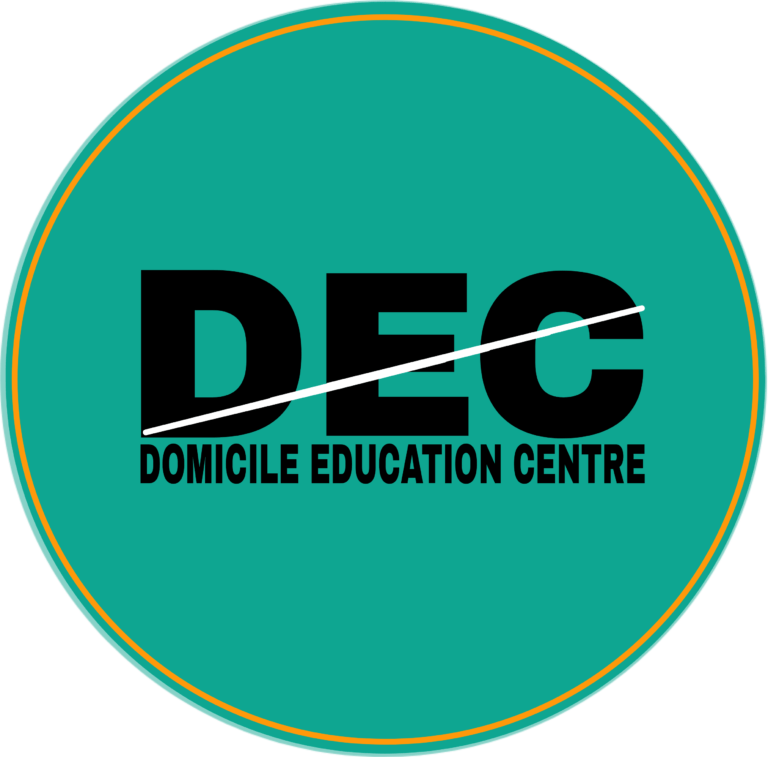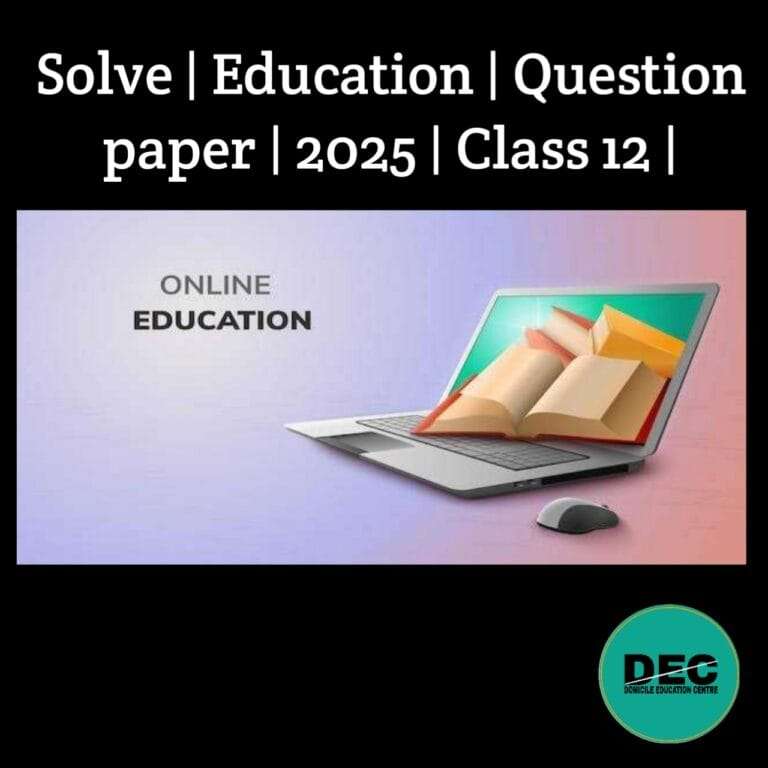Here You will get Solution Education Question Paper 2025 for Class-12.
2025
EDUCATION
Full marks: 100
Pass marks: 30
Time: Three hours
The figures in the margin indicate full marks for the questions.
- No. 1 carries 1 marks each …………………. 1 x 12 = 12
- No. 2 carries 2 marks each …………………. 2 x 12 = 24
- No. 3 carries 4 marks each …………………. 4 x 10 = 40
- No. 4 carries 6 marks each …………………. 6 x 4 = 24
Total = 100
1. Answer the following questions: (any twelve) 1 x 12=12
Fill in the Blanks:
(a) The Indira Gandhi National Open University was established in __________.
Ans: 1985
(b) On the basis of the recommendation of __________ Commission Government of Assam decided to change some high schools into multiple school.
Ans: Secondary Education Commission 1952-53.
(c) Prior to ___________ Secondary education in Assam was controlled by the Gauhati University and Government of Assam.
Ans: 1962
(d) The concept of correspondence education was first introduced by ______ in 1840.
Ans: Issac Pitman
(e) The name of the largest Open University of the world is _______.
Ans: Indira Gandhi National Open University.
(e) World Environment Day is celebrated on ___________.
Ans: Every year 5th June is celebrated as ‘World Environment Day’.
(f) Ivan Pavlov was a Russian Physiologist and __________.
Ans: Psychologist.
(g) Conditioning method of learning establishes bond between natural tendency and __________.
Ans: Artificial stimulus.
Give short answer in one sentence:
(h) Which Education Commission suggested the 10+2+3 structure of education?
Ans: Kothari Commission 1964-66.
(i) “Non formal education differs from formal education in the sense that it takes place outside the formal school system” -Who said this?
Ans: According to J.P Naik.
(j) “Physical education is the sum of changes in the individual caused by experiences centring motor activity.” Who said this?
Ans: According to Cassidy.
(k) “Learning is both acquisition and retention of habit, knowledge and attitudes.” Who said this statement?
Ans: According to Skinner.
(l) What is voluntary or volitional attention?
Ans: When an individual is physically and mentally ready to pay attention and he does it out of his own will, is called Voluntary or Volitional attention. For example: A student with strong will to shine in life will pay attention to his studies in spite of poverty.
(m) What is image memory?
Ans: The memory which depends purely on the image of past experience and learning retained in mind is called Image Memory. It requires high intelligence, creativity, imaginative ability of an individual.
(n) What is Mode?
Ans: The number of scores that occurs in the list several times which is known as Mode.
(o) Write the formula for finding out first quartile from groups data.
Ans: (Let check chapter 7).
2. Answer any twelve of the following questions? 2 x 12= 24
(a) Write two suggestions of Kothari Commission regarding education and productivity.
Ans: The two suggestions of Kothari Commission regarding ‘Education and Productivity’ are mentioned below:
i. The Kothari Commission suggested Education should be job oriented and greater importance should be given to education in agriculture, science, industrial and technical subjects.
ii. In place of bookish knowledge, Education greater importance should be attached to the acquisition of practical knowledge and skills.
(b) Write two importance of vocationalisation secondary education in the present context.
Ans: The two importance of vocationalization of secondary education are mention below:
i. It can solve the socio-economic problems including the problem of unemployment in the youths.
ii. It helps the state in making effective use of man power resources for country’s development.
(c) Write two objectives of “Operational Blackboard” scheme.
Ans: The two objectives of “Operational Blackboard” scheme are mention below:
(i) To provide minimum facilities in all primary education such as blackboards, two reasonably large classroom, maps, charts, and other essential materials.
(ii) To appoint at least two teachers in each primary schools in the beginning and afterwards more teachers may be appointed as new classes are added.
(d) Define the concept of physical education.
Ans: According to Cassidy, “Physical education is the sum of changes in the individual caused by experiences centring motor activity.”
(e) What do you mean by value education?
Ans: Value Education refers to the form of education that covers all aspects of personality development which endeavours the values of moral, aesthetic, intellectual, social and spiritual development for the good of the society and the individual life is called Value Education.
(f) Define the concept of women empowerment.
Ans: Women Empowerment refers to the process of providing power to women who have been suffering from various disabilities, inequalities and gender discrimination to become free from the control of others, to assume power to control her own life and to determine her own conditions is called Women Empowerment.
(g) Write two differences between maturation and learning.
Ans: The two difference between Maturation and Learning are mentioned below:
(i) Learning is a result of Environmental Stimulus. On the other hand, Maturation is biological in nature.
(ii) Maturation occurs due to neural and muscular development. On the other hand, Learning takes place through practice and experience.
(h) What do you mean by law of readiness in learning?
Ans: Law of readiness emphasizes the importance of readiness to learn. Readiness depends on maturation and experience of the learner simultaneously. When a pupil feels to learn, he or she can learn more quickly and effectively. But when he or she not ready to learn, he or she can-not learn effectively so that according to Thorndike physical readiness is necessary for learning.
(i) What is retention?
Ans: Retention means that how long a person can retain his past experience and recall them when it is required.
(j) What is retroactive inhibition?
Ans: S.S. Chauhan said, “Retro-active inhibition means that something works backward to block something else.”
Archives
(k) Write any two characteristics of attention.
Ans: The two characteristics of Attention are mentioned below:
i. Attention is not a mental power, but a mental activity.
ii. Attention is not paid to each and everything that stimulate our sense organs.
(l) Define the concept of mental health and hygiene.
Ans: Mental health’ very simply means the state of being mentally free from illness or injury. Where as, ‘Mental hygiene’ is a science that attempt to develop and apply principles and techniques for the preservation and promotion of mental health as well as for the prevention and treatment of mental disorder, disease and other abnormalities, leading to an adequate adjustment and balanced development of one’s personality.
(m) Write two objectives of mental hygiene.
Ans: The two objectives of mental hygiene are mentioned in the following ways:
i. To develop healthy human relationship and group interaction between personality development and life experiences.
ii. To prevention and improvement of the mental health of the individual and the group.
(n) Define the preventive function of mental hygiene.
Ans: Preventive function of mental hygiene refers to understand the causes and ways and means of preventive measures to overcome the problems concerning to mental illness, personality disorders and adjustment process of the human child. For example: problems like- insecurity, unlawfulness, ignorance, sickness, etc.
(o) Find the Median and Mode from the following data: 1 + 1=2
58, 42, 30, 64, 57, 42, 34, 53, 44 and 38
Ans: (Let check chapter 7).
(p) Write two merits of quartile deviation as a measure of variability.
Calendar of Content List:
| M | T | W | T | F | S | S |
|---|---|---|---|---|---|---|
| 1 | 2 | |||||
| 3 | 4 | 5 | 6 | 7 | 8 | 9 |
| 10 | 11 | 12 | 13 | 14 | 15 | 16 |
| 17 | 18 | 19 | 20 | 21 | 22 | 23 |
| 24 | 25 | 26 | 27 | 28 | 29 | 30 |


Recent Comments